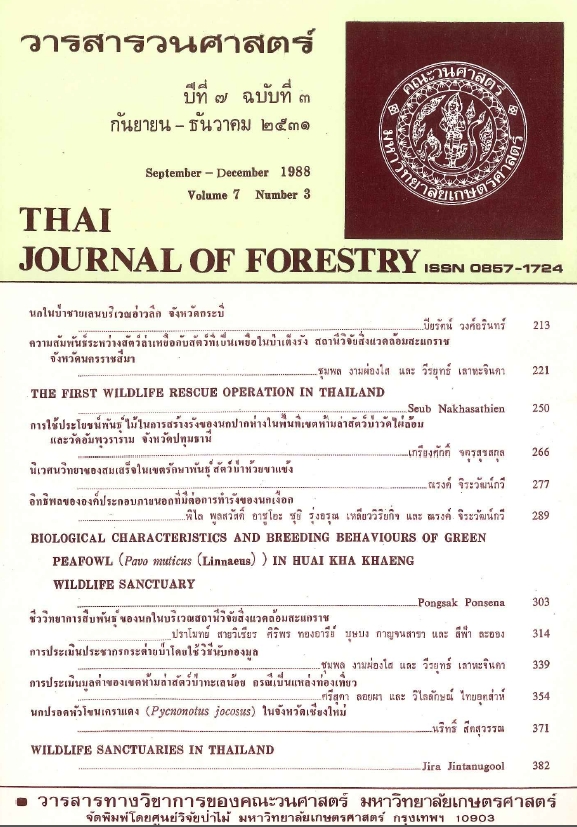THE FIRST WILDLIFE RESCUE OPERATION IN THAILAND
Main Article Content
บทคัดย่อ
The first wildlife rescue operation in Thailand was recorded Chiew Larn Dam, Surathani province, in January 1985. The Chiew Larn hydro-electric dam inundated 165 square kilometres of the largest area of lowland evergreen forest left in Thailand, creating 241 islands of which 162 would be permanent once the reservoir reached its peak storage level at 95 metres above sea level. The six largest of these islands would range in size from 0.74 to 1.28 square kilometres. During construction of the dam, a concerned wildlife rescue operation was undertaken for the first time in Thailand. Between April 1986 and September 1987, 1,364 animals were rescued (586 mammals, 58 birds, 720 reptiles). Forty-one mammals and two birds died following capture, others were found already dead by drowning or starvation. The survivors were released into the wildlife sanctuary or national park lying to the East and West of the reservoir. Despite these apparently satisfactory results, it argued that this project cannot rightly be considered a success because (i) it could not be completed within the time allowed and no animals have yet been rescued from the islands that would remain once the water reached 95 metres (msl), (ii) no survey was carried out to establish the number and density of species occuring in the area so it is not known what proportion of the total number of animals affected in the dam was encountered by the rescue team, (iii) animals were not monitored after being released so subsequent mortality rates are not known but are presumed to have been high, (iv) there are as yet no plans to monitor or manage the animals left stranded on the islands though their survival prospects are poor. It was also argued that future wildlife rescue operations must be preceded by a comprehensive survey of the area to be affected, must be given adequate time to do the job properly and must be followed by an equally comprehensive project to monitor the relocated animals. Even then, a wildlife rescue operation cannot compensate for the loss of wildlife habitat and should not be considered a strategy for nature conservation.
Downloads
Article Details

อนุญาตภายใต้เงื่อนไข Creative Commons Attribution-NonCommercial-NoDerivatives 4.0 International License.
ข้าพเจ้าและผู้เขียนร่วม (ถ้ามี) ขอรับรองว่า ต้นฉบับที่เสนอมานี้ยังไม่เคยได้รับการตีพิมพ์และไม่ได้อยู่ในระหว่างกระบวนการพิจารณาตีพิมพ์ลงในวารสารหรือสิ่งตีพิมพ์อื่นใด ข้าพเจ้าและผู้เขียนร่วม (ถ้ามี) ยอมรับหลักเกณฑ์และเงื่อนไขการพิจารณาต้นฉบับ ทั้งยินยอมให้กองบรรณาธิการมีสิทธิ์พิจารณาและตรวจแก้ต้นฉบับได้ตามที่เห็นสมควร พร้อมนี้ขอมอบลิขสิทธิ์ผลงานที่ได้รับการตีพิมพ์ให้แก่วารสารวนศาสตร์ คณะวนศาสตร์ มหาวิทยาลัยเกษตรศาสตร์ กรณีมีการฟ้องร้องเรื่องการละเมิดลิขสิทธิ์เกี่ยวกับภาพ กราฟ ข้อความส่วนใดส่วนหนึ่ง หรือ ข้อคิดเห็นที่ปรากฏในผลงาน ให้เป็นความรับผิดชอบของข้าพเจ้าและผู้เขียนร่วม (ถ้ามี) แต่เพียงฝ่ายเดียว และหากข้าพเจ้าและผู้เขียนร่วม (ถ้ามี) ประสงค์ถอนบทความในระหว่างกระบวนการพิจารณาของทางวารสาร ข้าพเจ้าและผู้เขียนร่วม (ถ้ามี) ยินดีรับผิดชอบค่าใช้จ่ายทั้งหมดที่เกิดขึ้นในกระบวนการพิจารณาบทความนั้น”


